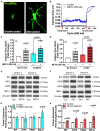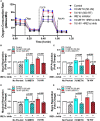A Non-Canonical Role for IRE1α Links ER and Mitochondria as Key Regulators of Astrocyte Dysfunction: Implications in Methamphetamine use and HIV-Associated Neurocognitive Disorders
- PMID: 35784841
- PMCID: PMC9247407
- DOI: 10.3389/fnins.2022.906651
A Non-Canonical Role for IRE1α Links ER and Mitochondria as Key Regulators of Astrocyte Dysfunction: Implications in Methamphetamine use and HIV-Associated Neurocognitive Disorders
Abstract
Astrocytes are one of the most numerous glial cells in the central nervous system (CNS) and provide essential support to neurons to ensure CNS health and function. During a neuropathological challenge, such as during human immunodeficiency virus (HIV)-1 infection or (METH)amphetamine exposure, astrocytes shift their neuroprotective functions and can become neurotoxic. Identifying cellular and molecular mechanisms underlying astrocyte dysfunction are of heightened importance to optimize the coupling between astrocytes and neurons and ensure neuronal fitness against CNS pathology, including HIV-1-associated neurocognitive disorders (HAND) and METH use disorder. Mitochondria are essential organelles for regulating metabolic, antioxidant, and inflammatory profiles. Moreover, endoplasmic reticulum (ER)-associated signaling pathways, such as calcium and the unfolded protein response (UPR), are important messengers for cellular fate and function, including inflammation and mitochondrial homeostasis. Increasing evidence supports that the three arms of the UPR are involved in the direct contact and communication between ER and mitochondria through mitochondria-associated ER membranes (MAMs). The current study investigated the effects of HIV-1 infection and chronic METH exposure on astrocyte ER and mitochondrial homeostasis and then examined the three UPR messengers as potential regulators of astrocyte mitochondrial dysfunction. Using primary human astrocytes infected with pseudotyped HIV-1 or exposed to low doses of METH for 7 days, astrocytes had increased mitochondrial oxygen consumption rate (OCR), cytosolic calcium flux and protein expression of UPR mediators. Notably, inositol-requiring protein 1α (IRE1α) was most prominently upregulated following both HIV-1 infection and chronic METH exposure. Moreover, pharmacological inhibition of the three UPR arms highlighted IRE1α as a key regulator of astrocyte metabolic function. To further explore the regulatory role of astrocyte IRE1α, astrocytes were transfected with an IRE1α overexpression vector followed by activation with the proinflammatory cytokine interleukin 1β. Overall, our findings confirm IRE1α modulates astrocyte mitochondrial respiration, glycolytic function, morphological activation, inflammation, and glutamate uptake, highlighting a novel potential target for regulating astrocyte dysfunction. Finally, these findings suggest both canonical and non-canonical UPR mechanisms of astrocyte IRE1α. Thus, additional studies are needed to determine how to best balance astrocyte IRE1α functions to both promote astrocyte neuroprotective properties while preventing neurotoxic properties during CNS pathologies.
Keywords: astrogliosis; metabolic function; mitochondria-associated ER membranes; neurodegeneration; neuroinflammation; unfolded protein response.
Copyright © 2022 Proulx, Stacy, Park and Borgmann.
Conflict of interest statement
The authors declare that the research was conducted in the absence of any commercial or financial relationships that could be construed as a potential conflict of interest.
Figures








Similar articles
-
HIV-1 and methamphetamine co-treatment in primary human astrocytes: TAARgeting ER/UPR dysfunction.NeuroImmune Pharm Ther. 2024 Feb 19;3(2):139-154. doi: 10.1515/nipt-2023-0020. eCollection 2024 Jun. NeuroImmune Pharm Ther. 2024. PMID: 39175523 Free PMC article.
-
HIV-1-associated inflammation and antiretroviral therapy regulate astrocyte endoplasmic reticulum stress responses.Cell Death Discov. 2017 Dec 4;3:17061. doi: 10.1038/cddiscovery.2017.61. eCollection 2017. Cell Death Discov. 2017. PMID: 29354290 Free PMC article.
-
Cal'MAM'ity at the Endoplasmic Reticulum-Mitochondrial Interface: A Potential Therapeutic Target for Neurodegeneration and Human Immunodeficiency Virus-Associated Neurocognitive Disorders.Front Neurosci. 2021 Oct 21;15:715945. doi: 10.3389/fnins.2021.715945. eCollection 2021. Front Neurosci. 2021. PMID: 34744606 Free PMC article. Review.
-
Methamphetamine Augments Concurrent Astrocyte Mitochondrial Stress, Oxidative Burden, and Antioxidant Capacity: Tipping the Balance in HIV-Associated Neurodegeneration.Neurotox Res. 2018 Feb;33(2):433-447. doi: 10.1007/s12640-017-9812-z. Epub 2017 Oct 9. Neurotox Res. 2018. PMID: 28993979 Free PMC article.
-
HIV-1, methamphetamine and astrocytes at neuroinflammatory Crossroads.Front Microbiol. 2015 Oct 27;6:1143. doi: 10.3389/fmicb.2015.01143. eCollection 2015. Front Microbiol. 2015. PMID: 26579077 Free PMC article. Review.
Cited by
-
MAM kinases: physiological roles, related diseases, and therapeutic perspectives-a systematic review.Cell Mol Biol Lett. 2025 Mar 28;30(1):35. doi: 10.1186/s11658-025-00714-w. Cell Mol Biol Lett. 2025. PMID: 40148800 Free PMC article.
-
HIV-1 and methamphetamine co-treatment in primary human astrocytes: TAARgeting ER/UPR dysfunction.NeuroImmune Pharm Ther. 2024 Feb 19;3(2):139-154. doi: 10.1515/nipt-2023-0020. eCollection 2024 Jun. NeuroImmune Pharm Ther. 2024. PMID: 39175523 Free PMC article.
-
The Role and Mechanism of TRIM13 Regulation of TRAF6 Ubiquitination in the Synergy of Inflammatory Responses and Neurotoxicity Induced by METH and HIV- 1 Tat Protein in Astrocytes.Neurotox Res. 2025 Apr 7;43(2):21. doi: 10.1007/s12640-025-00743-5. Neurotox Res. 2025. PMID: 40192895
-
Connection Between HIV and Mitochondria in Cardiovascular Disease and Implications for Treatments.Circ Res. 2024 May 24;134(11):1581-1606. doi: 10.1161/CIRCRESAHA.124.324296. Epub 2024 May 23. Circ Res. 2024. PMID: 38781302 Free PMC article. Review.
-
Mechanisms and treatments of methamphetamine and HIV-1 co-induced neurotoxicity: a systematic review.Front Immunol. 2024 Aug 19;15:1423263. doi: 10.3389/fimmu.2024.1423263. eCollection 2024. Front Immunol. 2024. PMID: 39224601 Free PMC article.
References
Grants and funding
LinkOut - more resources
Full Text Sources
Research Materials

